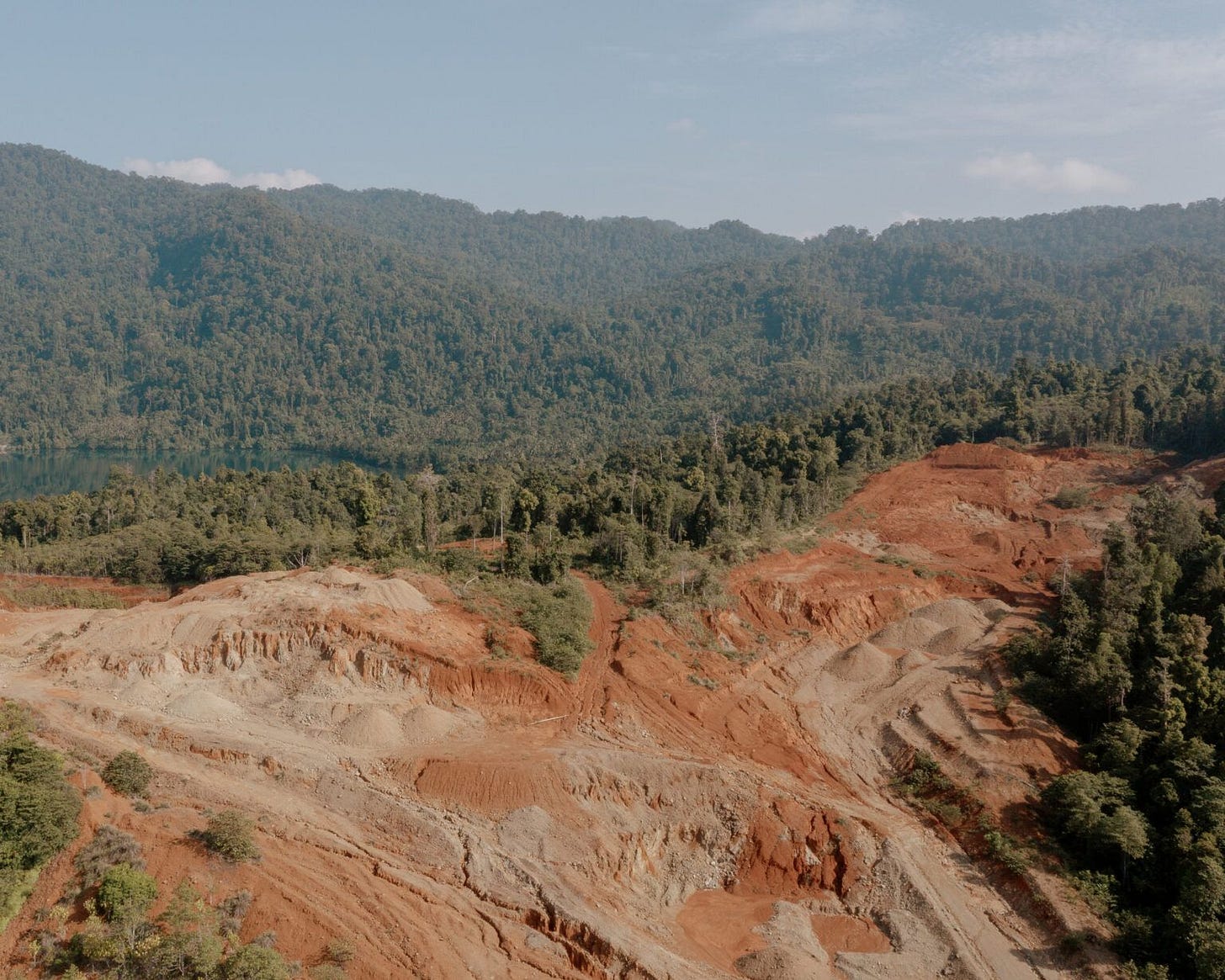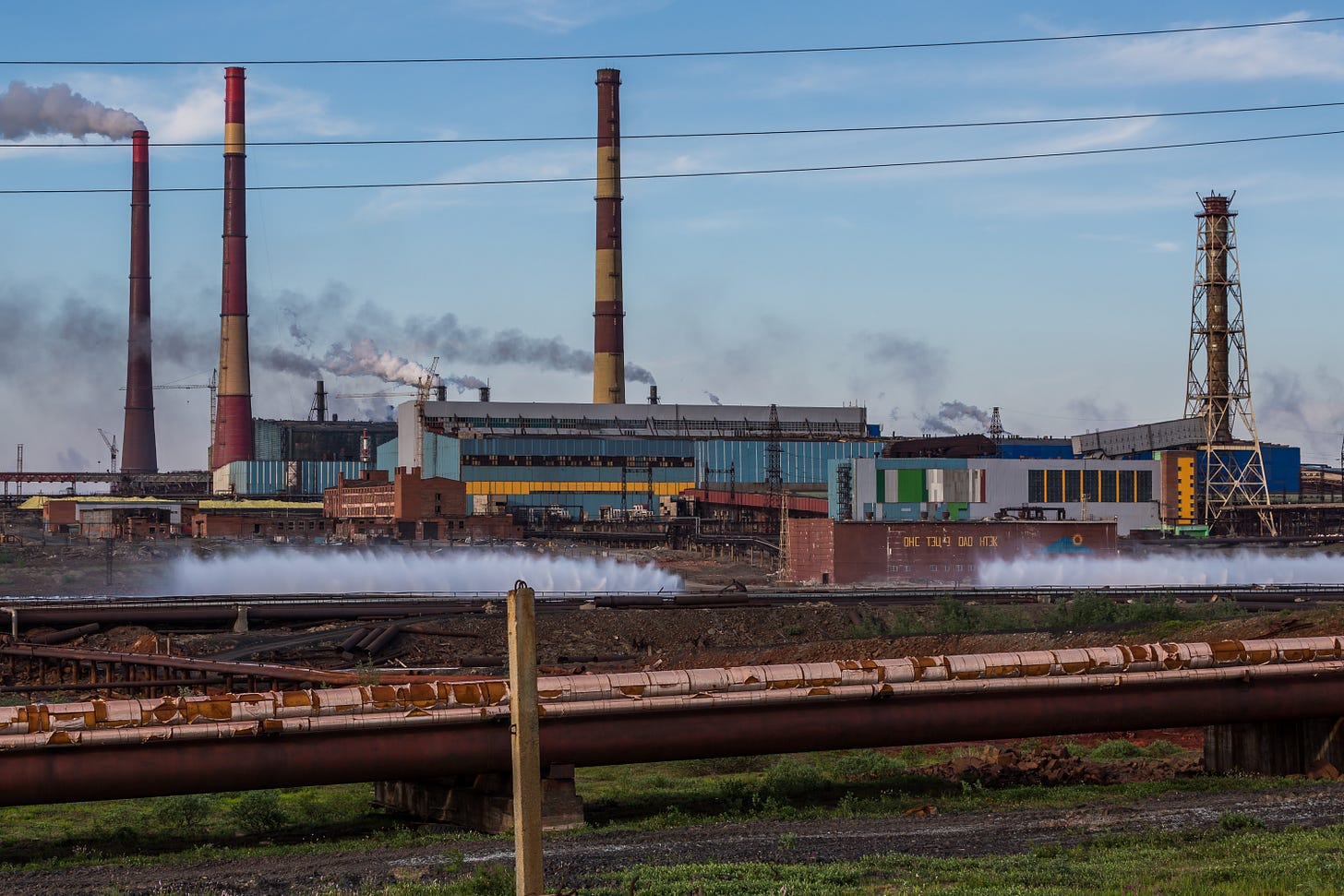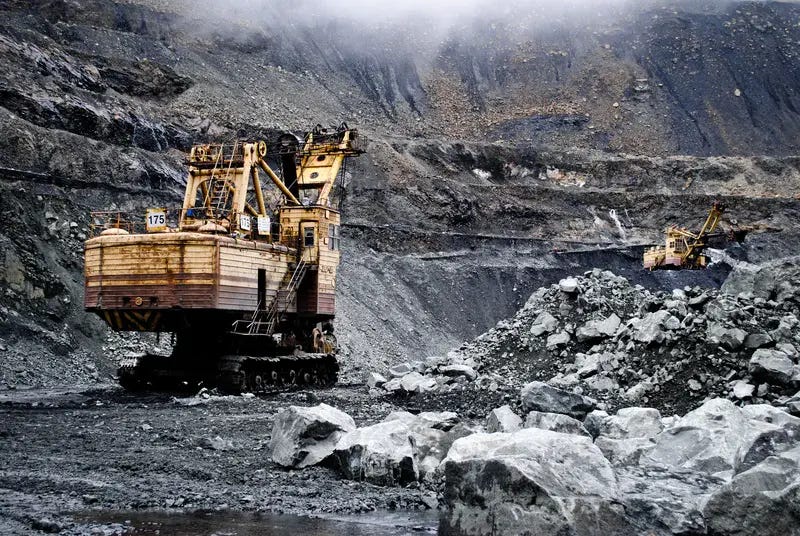It Takes a Forest to Make ‘Green’ Energy
Electric cars, wind turbines and solar panels all need nickel, but mining for this metal has poisoned water and devastated landscapes. Now, a new nickel mine in the U.S. is awaiting approval.

The months-long occupation of Michigan’s sacred Eagle Rock site wasn’t a long-ago Buffalo Bill-era event, but rather an attempt just 15 years ago by Native Americans and the local community to stop construction of the one and only nickel mine in the U.S.
But despite such prolonged protests, along with litigation that drew a turnout of over 500 tribal members from the Keweenaw Bay Indian Community to the Lansing courthouse, the Eagle nickel and copper mine, a relatively small (by industry standards) mining enterprise located in Michigan’s upper peninsula just ten miles uphill from the banks of Lake Superior, was given the go-ahead to begin operations in the fall of 2014.
Mining and processing nickel and copper has always been a dirty business. It results in deforestation, contaminates the air and water, and even produces acid rain. But despite environmental concerns, the Eagle Mine may soon have company, in the form of the Tamarack Nickel Project in the northeastern corner of neighboring Minnesota (more on that in a minute.)
Ironically, while the mining and refining of nickel unfailingly leaves behind a path of environmental ruin, this metal, which is mostly used in the production of stainless steel, is also an intrinsic element in the so-called “green revolution.” Nickel, in fact, now holds a special status as the “critical” component that’s moving the “clean” and “green” energy transition forward with its all-important use in wind turbines, solar panels, and most significantly, electric vehicles.
“Please mine more nickel, okay?”
The huge amount of destruction caused by nickel mining in Indonesia has been well-documented. In Halmahera, the largest island of the Maluku archipelago in the eastern part of the country, the devastation caused by nickel mining and smelting was detailed in a report last year by Climate Rights International. “Some companies,” the CRI report states, “in coordination with Indonesian police and military personnel, have engaged in land grabbing, coercion, and intimidation of Indigenous Peoples and other communities…”

Six hundred miles away on the Indonesian island of Kabaena, the impact of nickel mining looms over the Bajau, whose livelihood of fishing, diving, and harvesting shellfish is being erased by rapid deforestation and intense environmental damage that’s killing the fish and muddying the water.
But other parts of the world have also been blessed — or cursed — with mineral riches as well.
Currently, the main momentum behind a proposed new high-grade nickel mine in the U.S. is being generated by the ever-growing electric vehicle battery market, something President Trump is now backing despite years of mocking EVs. Tesla’s Elon Musk was even given a bold sales pitch by the president, who decorated the White House lawn with the brand’s latest models and announced he would buy one in mid-March.
While some EVs and hybrids contain nickel-free LFP (lithium iron phosphate) batteries, which are manufactured almost 100 percent in China, nothing beats the longer driving range and high-power density of NCM (nickel cobalt manganese) versions. And even as car manufacturers talk about utilizing more LFP batteries that are cheaper and charge faster, it appears that the nickel content in certain EV batteries is increasing – up eight percent in 2023 from the previous year.
According to 2024 data, for both the European and U.S. market, less than 10 percent of EVs utilized nickel-free LFP batteries.
As far as Tesla goes, in 2020 Musk was quoted by Fortune as saying “Any mining companies out there, please mine more nickel, okay?” Musk added that his company would award a “giant contract” for nickel mined “efficiently and in an environmentally sensitive way.”
Of course, environmental sensitivity in this kind of ecologically draining activity is difficult to define. So is knowing where the nickel in your EV comes from or who was involved in the mining.
In Indonesia, many operations (including the smelting process, which is used in coal-fired plants) are run by Chinese companies, which utilize thousands of workers from China brought in under unknown circumstances. Last year ABC News revealed how these individuals, who are laboring in the mines under incredibly dangerous conditions, have had their passports confiscated and are forced to live in compounds they are unable to leave without permission.
Nickel, in fact, might easily be dubbed the new “blood diamond.”
You also really can’t trace the nickel used by Tesla, Toyota, or any other vehicle manufacturer, due to the global nature of the supply chain.
But there’s one particular brand of “class 1” nickel (the type required for EV batteries) that the U.S. has banned from import.
Nyet to your nickel
In April of 2024 the U.S. Department of the Treasury, in coordination with the UK, issued Executive Order 14068 prohibiting aluminum, copper, and nickel “of Russian Federation origin” produced before April 13, 2024, from entering the U.S.
In a press release issued at that time Jeremy Hunt, chancellor of the U.K. equivalent of the U.S. Treasury, said that the action would “prevent the Kremlin funneling more cash into its war machine” by banning Russian-mined metals from the two biggest exchanges.
“Disabling Putin’s capacity to wage his illegal war in Ukraine is better achieved when we act alongside our allies,” said Hunt.
Although Indonesia is by far the largest nickel-producing country in the world, Russia, which holds the number-three spot, shines when it comes to the high-grade class-one nickel needed by Tesla and other EV manufacturers.
David Guberman, a trade analyst at the U.S. International Trade Commission (described on his LinkedIn page as being an “independent, quasijudicial Federal agency with broad investigative responsibilities on matters of trade”) outlined the situation in a 2024 paper titled Impact of the Russian Invasion of Ukraine on Global Nickel Trade.
According to Guberman, prior to early 2022, Russia was a “key source of nickel for the EV battery supply chain…” Nornickel, the leading Russian producer of mined and refined nickel, lost big because of those sanctions, with its profits dropping over 50 percent down to $2.9 billion from the previous year, Guberman said.
But if – or more likely when – the U.S./Russia nickel trade resumes, it’s far from an environmental prize.

Ecocide in the Arctic
Norilsk is the northernmost city in the world, located in deepest Siberia around 180 miles north of the Arctic Circle. This once pristine and unique environment is now well known as one of the “most polluted places on Earth” all due to Norilsk Nickel (also known as Nornickel).
If you’re in need of that super-pure class-one EV battery-grade nickel, Nornickel is the company that mines and refines it, destroying the forests and contaminating the water and air in the process.
NASA, which monitors the output of pollutants from Nornickel, states that the sulfide ore-extraction process at the plant produces nearly two million tons of sulfur dioxide every year. The resulting acid rain is responsible for the destruction of the downwind boreal forest, turning one of the world’s largest “carbon sinks” that provide a natural way for carbon dioxide to be absorbed from the atmosphere into a wasteland of dead and dying trees spread across nearly six million acres.
The decades of environmental destruction produced by Nornickel have proved so potent that the once-solid permafrost many buildings of the plant were constructed on is steadily melting due to discharged chemicals lowering the freezing point of water, according to NASA.
But it seems you just can’t say “clean-energy technology” without finding that nickel is somehow involved.
Described as the “hidden powerhouse” and the “true hero” of wind turbines, nickel is incorporated into them in “significant” amounts to strengthen the steel they are made from. According to the Nickel Institute, each turbine utilizes around 4,400 pounds of nickel.
The metal is also said to be “vital” to the durability and conductivity of solar panels.

Prove it First
To call Tamarack, Minnesota a small town is an understatement. Its 2020 census count was a mere 62.
But whatever it lacks in population it makes up for in biodiversity. A mix of boreal wetlands supports a wide range of animal and plant species, along with unique tamarack trees, native conifers that lose their needles in the fall.

Tamarack, home to members of the Mille Lacs Band of Ojibwe, a federally recognized American Indian tribal government, sits atop extremely high-grade nickel deposits, a gift from a volcano that was active over one billion years ago. The proposed mine location also is well within the Mille Lacs territory that was ceded to the Band in an 1855 treaty. The Band’s opposition to the Tamarack mine is detailed on its website, Water Over Nickel.
While the planned mine in Tamarack may be somewhat different than what other communities have faced in fighting exploitation of their natural resources, the scenario is quite similar.
Whenever a valuable resource is located, it’s not uncommon for foreign-owned corporations to swoop in and stake a claim, saying how necessary, clean, and environmentally sound their operation will be. State officials then hold meetings and create reams of paperwork to prove that point, with the promise of local jobs always playing a part.
For Tamarack, that role is being played by Talon Metals Corp, headquartered in the British Virgin Islands, and Rio Tinto, a British and Australian-owned firm with a long and checkered past in the mining business.
Talon Metals has made itself right at home in the community, with an unassuming local office out of a residential home, pictured on Google Maps as having a blue Tesla charging out front with a bumper guard reading, “EV’s NEED NICKEL.”
The company is pitching the green line with such vigor that it has even applied for a U.S. trademark for the phrase “Green Nickel.” But is it indeed possible to mine nickel without ravaging the environment?
Talon plans to bore down 350 feet into the bedrock, at which point it will start blasting operations. The resulting millions of gallons of water freed every day will be pumped to the surface, the company says, then treated and released into wetlands, lakes, and eventually the Mississippi River. Talon is so confident its plan will get permitted to go forward that it entered into a contract with Tesla back in January of 2022 to bring the carmaker 165 million pounds of “nickel in concentrate” over a six-year period once mining operations begin.
But with the EPA having called such mining “America’s most toxic industry,” assurances of its being “green” appear hard to confirm.
Such confirmation is exactly what Minnesota’s “Prove it First” legislation is aiming for – in essence, to “prove” (with independent “scientific proof”) that a sulfide ore mine has operated for at least ten years anywhere in the U.S. and has been closed for at least another decade without causing environmental contamination (there have been 15 sulfide ore mines in the U.S., all but one for copper and none in Minnesota). Introduced in 2020, as of March 2025 the bill has been stonewalled by both state Democrats and Republicans.
Along with the Talon mine, two other much larger operations in Minnesota are potential threats, currently held back by legal challenges and an ongoing Biden administration cancellation of mineral leases.
Pete Marshall, communications director for Friends of the Boundary Waters (the “Boundary Waters” being a 1.1 million acre wilderness area in northeastern Minnesota) says that along with operating hazards, the real environmental dangers often don’t become apparent until after the mining operations cease.
“You’ve got this massive body of waste rock that has to coexist with the environment for hundreds of years,” and regardless of any “safeguards” that are put in place “the danger persists,” he said, adding that “Water does not respect any boundaries.” Water is at risk from “acid mine drainage,” which occurs when waste rock that is exposed to water and oxygen converts the sulfide minerals to sulfuric acid, releasing heavy metals in the process that seep into surface water and groundwater.
As for the Eagle Mine in Michigan, which the company states will be in operation until 2029 (or whenever the ore runs out), Marshall says that calling it an example of “clean” mining is unmistakably false.
Dr. Steven Emerman a geology and mining expert, also points out that the raw ore goes to another facility 32 miles south of Eagle Mine for processing, where sulfuric acid and wastewater spills have already been reported.
“The simple answer is that there are no non-polluting sulfide mines anywhere in the world,” Emerman noted in a letter to the Friends of the Boundary Waters.
“The sulfide mining industry has a perfect track record of water pollution,” he testified at the Minnesota capitol last February.
And the threat such operations pose to clean water, he warned, “lasts forever.”





Thanks Bill. This thing started as a six hundred word piece about an incident in indonesia! On the flip side we're probably safe from alien invasion after what humans have done to the earth.
Remember way back when Al Gore was screaming at us The oceans are rising! In ten years NYC wil be under water The polar ice caps are melting ! The sky is falling Climate change will kill us all if we don't reduce co2 in our atmosphere (btw co2 is what plant need to survive and in return they give us oxygen so we can survive)
And so the push to create a vehicle that doesn't need that nasty dirty petroleum to run and the electric car was born and the Greenies rejoiced, until now
Now we learn that all the elements and rare earth metals needed to build the perfect EV will annihilate the us from below by regurgitating all the pollutants from the bowels of the earth because we need to feed the monster we were told would save us
The Brothers Grimm couldn't have conceived of a more frightening tale So here we are in this fresh he'll now what do we do? I'll wait✋️